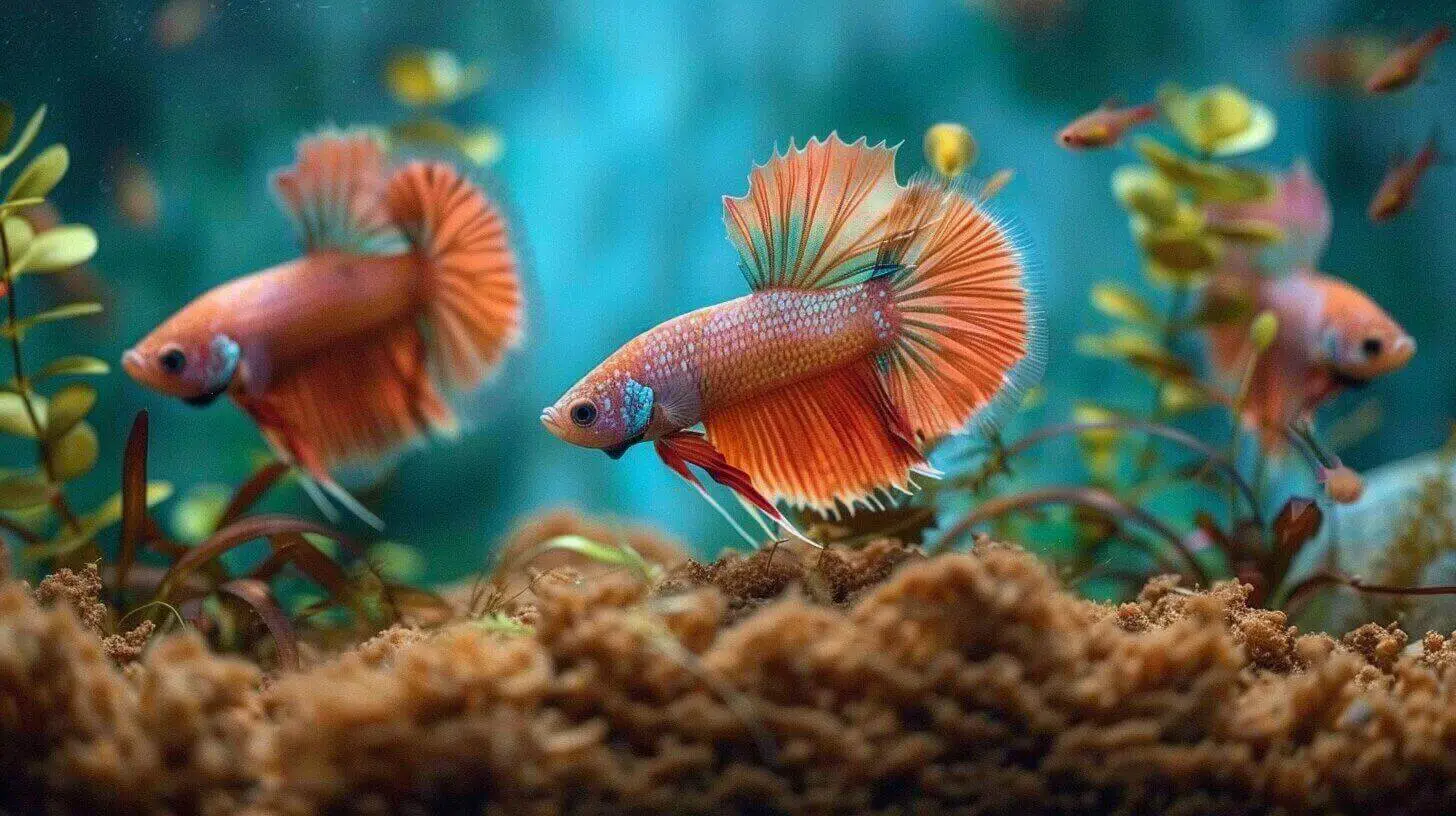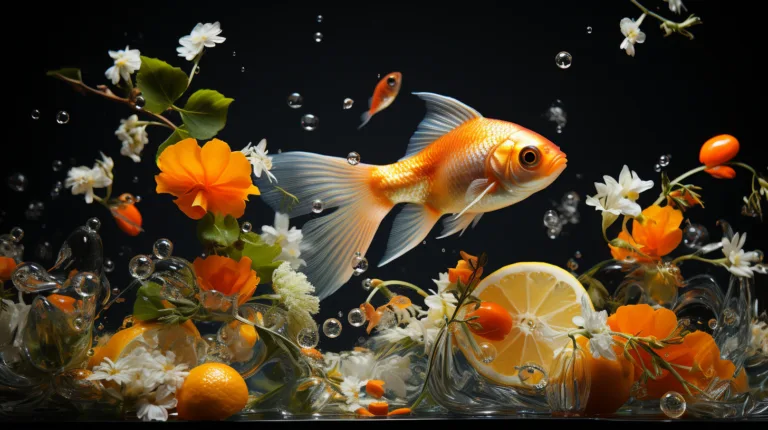Female betta fish in community tanks can be tricky. Many think they’re too mean for other fish. But that’s not always true! With the right setup, female bettas can live happily with tank mates. 1 This guide will show you how to do it right.
I’ve kept fish for years and learned a lot about bettas. I’ve seen firsthand how female bettas can thrive in community tanks. 2 In this post, you’ll get tips to make your tank a success.
Ready to learn? Let’s go! 3
Key Takeaways
- Female bettas can live well with other fish in tanks 5 to 10 gallons or larger.
- Good tank mates include corydoras catfish, neon tetras, and snails.
- Keep water between 72°F to 82°F and do 10% to 25% water changes every 2-4 weeks.
- Feed bettas 3 to 4 pellets once a day with one fasting day per week.
- Watch for health issues like dull colors, torn fins, or poor appetite.
Understanding Female Betta Fish in a Community Tank

Female bettas can thrive in community tanks with the right setup. They’re less aggressive than males, making them good tank mates for many fish species.
What Are Female Bettas and Their Characteristics?
Female bettas are colorful fish from Thailand. 1 They have shorter fins than male bettas. These fish like warm water between 72°F to 82°F. You can keep them in tanks of at least 5 gallons.
These fish come in many colors and patterns. They eat pellets, flakes, and live food. Female bettas can get sick with ich, fin rot, or dropsy. They need clean water and good care to stay healthy.
Female bettas bring vibrant life to any community tank. 2
The Behavior of Female Bettas in a Community Environment
Female bettas can thrive in community tanks with proper care. They often show less aggression than males, but still need watching. These fish may compete for food with other species like tetras. 2 To keep peace, add lots of plants and hiding spots in the tank. This gives your bettas places to retreat if stressed.
In groups, female bettas form a pecking order. The top fish may bully others at times. Watch for signs of stress such as fin nipping or chasing. A tank over 10 gallons helps reduce fights by giving each fish more space. 2 Peaceful tank mates like corydoras or rasboras usually get along well with female bettas.
Ideal Conditions for Keeping Female Betta Fish in Your Tank
Female betta fish need specific conditions to thrive in a community tank. Here’s what you need to provide for their health and happiness:
- Tank size: Use a 10-gallon tank or larger. This gives your betta enough space to swim and reduces stress. 2
- Water temperature: Keep it between 72°F to 82°F. Use a heater to maintain steady warmth.
- pH level: Aim for 6.0-8.0. Test often and adjust as needed.
- Hiding spots: Add plants, caves, and decor. These give your betta places to rest and feel safe.
- Gentle filter: Install a low-flow filter. It keeps water clean without pushing your betta around.
- Tank mates: Choose calm fish like neon tetras or ghost shrimp. Avoid fin-nippers or aggressive species. 3
- Feeding area: Use a feeding ring. It helps your betta find food easily.
- Regular cleaning: Do partial water changes weekly. This keeps ammonia levels low.
- Light cycle: Provide 8 to 10 hours of light daily. Use a timer for consistency.
- Quarantine new fish: Keep new additions separate for 2 weeks. This prevents disease spread.
Best Tank Mates for Female Bettas

Female bettas can live with many fish friends. You’ll find great tank mates that get along well and make your tank lively.
Top 10 Best Tank Mates for Female Betta Fish
Female betta fish can thrive with the right tank mates. Here’s a list of 10 great companions for your betta:
- Corydoras Catfish: These bottom-dwellers clean up leftovers and get along well with bettas. Add 3 to 5 to your tank for best results.
- Neon Tetras: Bright and peaceful, these schooling fish add color to your tank. Keep 6 to 8 in a 20-gallon tank with your betta.
- Harlequin Rasboras: These small, active fish share the same waters as bettas in nature. A group of 6 to 8 works well in a community tank.
- African Dwarf Frogs: These cute amphibians are fun to watch and won’t bother your betta. Add 2 to 3 to your tank for variety. 3
- Nerite Snails: These algae-eaters help keep your tank clean. Add 1 to 2 per 5 gallons of water. 4
- Amano Shrimp: These peaceful cleaners are too big for bettas to eat. A group of 3 to 5 works well in a 20-gallon tank.
- Ember Tetras: Small and peaceful, these fish add a pop of orange to your tank. Keep 6 to 8 in a school.
- Kuhli Loaches: These eel-like fish are active at night and hide during the day. Add 3 to 5 to your tank for interest.
- Otocinclus Catfish: These tiny algae-eaters are peaceful and stay out of your betta’s way. Keep 3 to 5 in a group.
- Mystery Snails: These large snails come in many colors and help keep your tank clean. Add 1-2 to your aquarium.
Suitable Companions: Compatible Fish and Invertebrates
Now that you know the top tank mates for female bettas, let’s explore more compatible companions. These fish and invertebrates can live peacefully with your betta in a community tank.
- Snails: Nerite snails and mystery snails make great tank mates. They help clean up algae and don’t bother bettas. 4
- Shrimp: Ghost shrimp and cherry shrimp are small and peaceful. They add color and help keep the tank clean.
- African Dwarf Frogs: These tiny frogs are fun to watch and get along well with bettas. Keep 2 to 3 in a 20-gallon tank.
- Corydoras Catfish: These bottom-dwellers are calm and social. Get a group of 6 or more for best results.
- Tetras: Neon tetras and ember tetras are colorful and active. They do well in groups of 8 to 10.
- Harlequin Rasboras: These small fish are peaceful and like to school. Add 6 to 8 to your tank.
- Clown Plecos: These algae-eaters stay small and don’t bother bettas. They need driftwood in the tank.
- Live Plants: Java fern, anubias, and moss balls give hiding spots and improve water quality.
Avoiding Aggressive Tank Mates and Stressful Situations
Choose tank mates wisely for your female betta. Avoid aggressive fish that might nip fins or chase her. Pick calm species that won’t provoke fights. Use tank dividers if you spot any aggression. This keeps everyone safe and reduces stress. 5
Create a peaceful home for your betta. Add plenty of hiding spots with plants and decorations. Give her space to retreat when she feels threatened. Keep the tank clean and maintain stable water conditions.
A happy betta is less likely to show aggression. Next, let’s look at setting up the perfect habitat for female bettas. 6
Setting Up the Perfect Habitat for Female Bettas

Creating a cozy home for your female bettas is key to their happiness. You’ll need the right tank size, plants, and hiding spots. Read on to learn how to set up the perfect habitat for your finned friends!
Essential Aquarium Setup for Female Betta Fish
Female bettas need a well-planned tank setup to thrive. Here’s what you need for a perfect female betta habitat:
- Tank size: Get a 20-gallon tank for a betta sorority. This gives each fish enough space to swim and hide.
- Filtration: Use a gentle filter to keep water clean. Sponge filters work great for bettas and won’t hurt their fins.
- Heater: Keep the water at 72°F to 82°F. A good heater helps maintain this temp range.
- Substrate: Choose sand or small gravel. Bettas like to explore the bottom of the tank.
- Plants: Add live plants like Java fern or Anubias. They give hiding spots and clean the water.
- Hiding spots: Put in caves, driftwood, or ceramic decor. These help bettas feel safe and reduce stress.
- Black water: Use Indian almond leaves or driftwood to create tannins. This mimics their natural home.
- Lighting: Get a low to medium light setup. Bettas don’t need bright lights and prefer dim areas.
- Test kit: Buy a good water test kit. Check water weekly to keep it safe for your fish.
- Food: Stock up on high-quality betta pellets and frozen foods. A varied diet keeps bettas healthy.
Substrate and Decor: Creating a Comfortable Environment
Your female betta needs a cozy home. Here’s how to make her tank comfy:
- Choose the right substrate:
- Sand or fine gravel works bestAvoid sharp edges that could hurt finsDark colors help bettas feel safe.
- Add natural-looking decorations:
- Use smooth rocks or driftwood
- Avoid metal or painted items
- Create hiding spots with caves or tunnels.
- Include plenty of plants:
- Live plants improve water quality
- Silk plants are safe if you prefer artificial
- Floating plants give shade and resting spots.
- Create open swimming areas:
- Leave some space free of decor
- This lets bettas build bubble nests
- It also gives room to swim freely.
- Use a 10-gallon tank or larger:
- More space means less stress
- Bigger tanks are easier to keep clean
- You can add more tank mates safely.
- Set up different zones:
- Make areas for resting, hiding, and exploring
- Use plants to break up sight lines
- This helps reduce stress in community tanks.
- Keep decorations clean:
- Rinse new items before adding to tank
- Clean decor during water changes
- Replace any items that start to break down.
Maintaining Ideal Water Conditions for Female Bettas
Female bettas thrive in specific water conditions. Here’s how to keep their tank just right:
- Temperature control:
- Use a heater to maintain 72-82°F
- Check daily with a thermometer
- Avoid sudden changes
- pH balance:
- Keep pH between 6.0-8.0
- Test weekly with a pH kit
- Adjust slowly if needed
- Filtration:
- Cycle water 4+ times per hour
- Clean filter monthly
- Replace media as needed
- Water changes:
- Do 10-25% changes every 2-4 weeks
- Use a gravel vacuum
- Match new water temperature
- Water testing:
- Check ammonia, nitrite, nitrate weekly
- Use liquid test kits for accuracy
- Keep records to spot trends
- Aeration:
- Add an air stone for oxygenAdjust flow to avoid strong currentsPlace near plants for CO2 exchange
Feeding and Care for Female Betta Fish

Feeding your female betta right keeps her happy and healthy. Learn what to feed her and how often to do it.
Recommended Diet and Feeding Schedule for Bettas
Betta fish thrive on a simple diet. Give your betta 3 to 4 pellets once a day. Use high-quality food like North Fin Betta Bits. These pack the right nutrients in each bite. Watch your fish’s belly – it should look slightly round after eating. Too big means you’re overfeeding.
Skip food one day each week. This helps prevent bloat and keeps your betta healthy. Adjust meals based on your fish’s size, activity, and tank temp. Small, frequent meals work best. Always remove uneaten food to keep the tank clean.
Nutritional Needs for Healthy Female Betta Growth
Female bettas need a protein-rich diet to thrive. Feed them foods with 30% to 40% crude protein content. Shrimp and krill make great protein sources. Avoid fillers like soy or rice that can cause bloating.
Offer a mix of frozen and live foods for variety. Bloodworms, daphnia, brine shrimp, and wingless fruit flies are top choices. These mimic a betta’s natural diet of insects and larvae.
A balanced diet keeps your female betta healthy and vibrant. Next, let’s look at signs of health problems in female bettas.
Signs of Health Problems and How to Address Them
Your betta’s health is key to a happy tank. Watch for these signs and act fast:
- Dull colors: Bright bettas are healthy. Faded hues mean stress or illness. Fix water quality and check diet.
- Torn or clamped fins: This shows injury or disease. Clean water and salt baths can help heal fins.
- Poor appetite: Skipping meals is a red flag. Try new foods and check water temp.
- Lethargy: Active bettas are healthy. Sluggish fish need water tests and maybe meds.
- White spots: These could be Ich. Raise tank temp and use aquarium salt for mild cases.
- Fuzzy growths: This is often fungus. Clean water and anti-fungal meds can cure it.
- Swollen belly: This might be constipation or worse. Fast the fish and feed peas.
- Gasping at surface: Low oxygen or gill issues cause this. Add air stones and test water.
- Frayed fins: Fin rot is common. Daily water changes and salt can fix early stages.
- Bulging eyes: This is a sign of infection. Clean water and antibiotics are needed.
Successfully Keeping Female Bettas in Your Aquarium

Keep your female bettas happy in a community tank for years. Learn more about long-term care and expert tips to make your aquarium thrive.
Long-Term Considerations for a Healthy Community Tank
A healthy community tank needs ongoing care. Check water quality weekly. Use a test kit to measure pH, ammonia, nitrite, and nitrate levels. Clean the filter monthly and do partial water changes every two weeks. Watch your fish for signs of stress or illness. Look for changes in color, appetite, or behavior.
Feed your bettas and tank mates a varied diet. Offer high-quality flakes, pellets, and frozen foods. Use feeding rings to ensure all fish get enough food. 2 Trim plants regularly to prevent overgrowth.
Replace old decorations that may harbor harmful bacteria. With proper care, your female betta community tank can thrive for years.
Resources for Further Learning and Betta Fish Care
Ready to dive deeper into betta care? Check out online forums about fish care. These sites offer expert advice and connect you with other betta lovers. Your local fish store may offer workshops on community tank setup. Don’t forget that there are YouTube channels for visual guides on betta keeping.
These resources will boost your skills in creating the perfect home for your female bettas.
Conclusion
Female bettas can thrive in community tanks with care. Pick peaceful tank mates and create a cozy habitat. Watch for signs of stress or aggression. Give your betta proper food and clean water.
With these steps, you’ll enjoy a happy, healthy community tank with your female betta fish.
FAQs
1. Can female bettas live in a community tank?
Yes, female bettas can live in a community tank… but with caution. They need a 20 gallon tank, heavily planted, to feel secure. Add them last, monitor closely.
2. How many female bettas can I keep together?
Keep at least 3 female bettas in a 10 gallon tank. More is better. This helps spread aggression. Don’t house just two females – it’s risky.
3. What fish make good tank mates for female bettas?
Chill fish are best. Think: small tetras, corys, or snails. Avoid bright colors or long fins. Don’t add male bettas or other Siamese fighting fish.
4. Do I need a separate tank for female bettas?
Not always. A community tank works if it’s large enough. But have a backup tank ready… just in case. Some bettas are too feisty for friends.
5. How do I stop fighting in my female betta tank?
Watch for stress and fighting. Remove aggressive females quickly. Add more plants, hiding spots. If it doesn’t stop, separate them.
6. Can I breed bettas in a community tank?
Don’t try it. Breeding needs a separate tank. It’s tricky, stressful for other fish. Stick to enjoying your peaceful community setup.
References
- ^ https://tropicflow.com/blogs/blog/female-betta-fish-everything-you-need-to-know?srsltid=AfmBOorqse7ZSr2dJGc-r3sCn11YpmpfO15nKeBrhL6ytW1qa3HnFBja (2023-09-17)
- ^ https://forum.aquariumcoop.com/topic/27053-community-tank-with-female-betta/ (2022-09-20)
- ^ https://tropicflow.com/blogs/female-betta-fish-blogs/female-betta-tank-mates?srsltid=AfmBOopJM44187gh5fDDG7jN6Wt9Xa2ec8jZDne-rOJhuhHbHN4UrREN (2024-07-31)
- ^ https://tropicflow.com/blogs/male-betta-fish-blog/the-betta-fish-tank-mate-guide-what-works-and-what-doesnt?srsltid=AfmBOoqbqQJ4uSG4pZ1m9dNbKgwmnFkjX4pgjDJx1ydee1EQoyrdvAxj
- ^ https://www.bettafish.com/threads/female-betta-tankmates.787290/
- ^ https://bettafish.org/betta-fish-tank-mates/ (2024-02-23)






